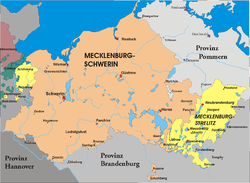This article relies largely or entirely on a single source. (July 2022) |
Duchy of Mecklenburg-Strelitz Herzogtum Mecklenburg-Strelitz (German) | |||||||||
|---|---|---|---|---|---|---|---|---|---|
| 1701–1815 | |||||||||
 | |||||||||
| Status | State of the Holy Roman Empire (until 1806) Independent duchy (1806–1808) Member of the Confederation of the Rhine (1808–1813) Independent duchy (1813–1815) | ||||||||
| Capital | Strelitz then Neustrelitz | ||||||||
| Religion | Lutheran | ||||||||
| Duke of Mecklenburg-Strelitz | |||||||||
• 1701–1708 | Adolphus Frederick II | ||||||||
• 1708–1752 | Adolphus Frederick III | ||||||||
• 1752–1794 | Adolphus Frederick IV | ||||||||
• 1794–1815 | Charles II | ||||||||
| History | |||||||||
• Treaty of Hamburg | 1701 | ||||||||
• Raised to Grand Duchy | 1815 | ||||||||
| |||||||||
| Today part of | Germany | ||||||||
Wikimedia Commons has media related to Duchy of Mecklenburg-Strelitz.
Preview warning: Commons category does not match the Commons sitelink on Wikidata – please check
The Duchy of Mecklenburg-Strelitz was a duchy in Northern Germany consisting of the eastern fifth of the historic Mecklenburg region, roughly corresponding with the present-day Mecklenburg-Strelitz district (the former Lordship of Stargard), and the western Principality of Ratzeburg exclave (the former Prince-Bishopric of Ratzeburg), which lay mostly in the west of the modern Nordwestmecklenburg district. At the time of its establishment, the main part of the duchy bordered on the territory of Swedish Pomerania in the north and of Brandenburg in the south; Ratzeburg bordered Saxe-Lauenburg and the Free City of Lübeck.

